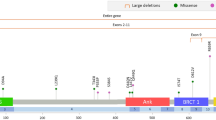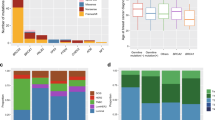Abstract
Germline mutations in the BRCA1, BRCA2 and Fanconi anaemia genes confer cancer susceptibility, and the proteins encoded by these genes have distinct functions in related DNA-repair processes. Emerging evidence indicates that these processes are disrupted by numerous mechanisms in sporadic cancers. Collectively, there are properties that define 'BRCAness' — that is, traits that some sporadic cancers share with those occurring in either BRCA1- or BRCA2-mutation carriers. These common properties might have important implications for the clinical management of these cancers.
This is a preview of subscription content, access via your institution
Access options
Subscribe to this journal
Receive 12 print issues and online access
$209.00 per year
only $17.42 per issue
Buy this article
- Purchase on Springer Link
- Instant access to full article PDF
Prices may be subject to local taxes which are calculated during checkout



Similar content being viewed by others
References
Wooster, R. & Weber, B. L. Breast and ovarian cancer. N. Engl. J. Med. 348, 2339–2347 (2003).
Venkitaraman, A. R. Cancer susceptibility and the functions of BRCA1 and BRCA2. Cell 108, 171–182 (2002).
Tutt, A. & Ashworth, A. The relationship between the roles of BRCA genes in DNA repair and cancer predisposition. Trends Mol. Med. 8, 571–576 (2002).
Venkitaraman, A. R. Tracing the network connecting BRCA and fanconi anaemia proteins. Nature Rev. Cancer 4, 266–276 (2004).
D'andrea, A. D. & Grompe, M. The fanconi anaemia/BRCA pathway. Nature Rev. Cancer 3, 23–34 (2003).
Merajver, S. D. et al. Somatic mutations in the BRCA1 gene in sporadic ovarian tumours. Nature Genet. 9, 439–443 (1995).
Futreal, P. A. et al. BRCA1 mutations in primary breast and ovarian carcinomas. Science 266, 120–122 (1994).
Lancaster, J. M. et al. BRCA2 mutations in primary breast and ovarian cancers. Nature Genet. 13, 238–240 (1996).
Sorlie, T. et al. Gene expression patterns of breast carcinomas distinguish tumor subclasses with clinical implications. Proc. Natl Acad. Sci. USA 98, 10869–10874 (2001).
Perou, C. M. et al. Molecular portraits of human breast tumours. Nature 406, 747–752 (2000).
Van 'T Veer, L. J. et al. Gene expression profiling predicts clinical outcome of breast cancer. Nature 415, 530–536 (2002).
Sorlie, T. et al. Repeated observation of breast tumor subtypes in independent gene expression data sets. Proc. Natl Acad. Sci. USA 100, 8418–8423 (2003).
Smalley, M. & Ashworth, A. Stem cells and breast cancer: a field in transit. Nature Rev. Cancer 3, 832–844 (2003).
Foulkes, W. D. et al. Germline BRCA1 mutations and a basal epithelial phenotype in breast cancer. J. Natl Cancer Inst. 95, 1482–1485 (2003).
Hedenfalk, I. et al. Gene-expression profiles in hereditary breast cancer. N. Engl. J. Med. 344, 539–548 (2001).
Jazaeri, A. A. et al. Gene expression profiles of BRCA1-linked, BRCA2-linked, and sporadic ovarian cancers. J. Natl Cancer Inst. 94, 990–1000 (2002).
Lakhani, S. R. et al. Profiling familial breast cancer. Nature Med. 7, 408–410 (2001).
Crook, T. et al. p53 mutation with frequent novel condons but not a mutator phenotype in BRCA1- and BRCA2-associated breast tumours. Oncogene 17, 1681–1689 (1998).
Greenblatt, M. S., Chappuis, P. O., Bond, J. P., Hamel, N. & Foulkes, W. P. TP53 mutations in breast cancer associated with BRCA1 or BRCA2 germ-line mutations: Distinctive spectrum and structural distribution. Cancer Res. 61, 4092–4097 (2001).
Bischoff, J. R. & Plowman, G. D. The aurora/ipl1p kinase family: regulators of chromosome segregation and cytokinesis. Trends Cell Biol. 9, 454–459 (1999).
Hanahan, D. & Weinberg, R. A. The hallmarks of cancer. Cell 100, 57–70 (2000).
Lakhani, S. et al. Basal markers and estogen receptor status are powerful predictors of germline BRCA1 mutations. Proc. Am. Assoc. Cancer Res. abstract 5593 (2004).
Tirkkonen, M. et al. Distinct somatic genetic changes associated with tumor progression in carriers of BRCA1 and BRCA2 germ-line mutations. Cancer Res. 57, 1222–1227 (1997).
Wessels, L. F. et al. Molecular classification of breast carcinomas by comparative genomic hybridization: a specific somatic genetic profile for brca1 tumors. Cancer Res. 62, 7110–7117 (2002).
Jones, P. A. & Baylin, S. B. The fundamental role of epigenetic events in cancer. Nature Rev. Genet. 3, 415–428 (2002).
Esteller, M. et al. Promoter hypermethylation and brca1 inactivation in sporadic breast and ovarian tumors. J. Natl Cancer Inst. 92, 564–569 (2000).
Rice, J. C. et al. Methylation of the BRCA1 promoter is associated with decreased BRCA1 mRNA levels in clinical breast cancer specimens. Carcinogenesis 21, 1761–1765 (2000).
Catteau, A. et al. Methylation of the BRCA1 promoter region in sporadic breast and ovarian cancer: correlation with disease characteristics. Oncogene 18, 1957–1965 (1999).
Geisler, J. P. et al. Frequency of BRCA1 dysfunction in ovarian cancer. J. Natl Cancer Inst. 94, 61–67 (2002).
Baldwin, R. L. et al. BRCA1 promoter region hypermethylation in ovarian carcinoma: a population-based study. Cancer Res. 60, 5329–5333 (2000).
Chan, K. Y. et al. Epigenetic factors controlling the BRCA1 and BRCA2 genes in sporadic ovarian cancer. Cancer Res. 62, 4151–4156 (2002).
Staff, S. et al. Haplo-insufficiency of BRCA1 in sporadic breast cancer. Cancer Res. 63, 4978–4983 (2003).
Bianco, T. et al. Tumour-specific distribution of BRCA1 promoter region methylation supports a pathogenetic role in breast and ovarian cancer. Carcinogenesis 21, 147–151 (2000).
Marsit, C. J. et al. Inactivation of the fanconi anemia/BRCA pathway in lung and oral cancers: implications for treatment and survival. Oncogene 23, 1000–1004 (2004).
Narayan, G. et al. Promoter hypermethylation of FANCF: disruption of fanconi anemia-BRCA pathway in cervical cancer. Cancer Res. 64, 2994–2997 (2004).
Futreal, P. A. et al. A census of human cancer genes. Nature Rev. Cancer 4, 177–183 (2004).
Baylin, S. & Bestor, T. H. Altered methylation patterns in cancer cell genomes: cause or consequence? Cancer Cell 1, 299–305 (2002).
Grushko, T. A. et al. Myc is amplified in BRCA1-associated breast cancers. Clin. Cancer Res. 10, 499–507 (2004).
Magdinier, F. et al. Down-regulation of BRCA1 in human sporadic breast cancer; analysis of DNA methylation patterns of the putative promoter region. Oncogene 17, 3169–3176 (1998).
Miller, B. J. et al. Pooled analysis of loss of heterozygosity in breast cancer: a genome scan provides comparative evidence for multiple tumor suppressors and identifies novel candidate regions. Am. J. Hum. Genet. 73, 748–767 (2003).
Beckmann, M. W. et al. Clinical impact of detection of loss of heterozygosity of BRCA1 and BRCA2 markers in sporadic breast cancer. Br. J. Cancer 73, 1220–1226 (1996).
Santarosa, M. & Ashworth, A. Haploinsufficiency for tumour suppressor genes: when you don't need to go all the way. Biochim. Biophys. Acta 1654, 105–122 (2004).
Baldeyron, C. et al. A single mutated BRCA1 allele leads to impaired fidelity of double strand break end-joining. Oncogene 21, 1401–1410 (2002).
Taniguchi, T. et al. Disruption of the fanconi anemia-BRCA pathway in cisplatin-sensitive ovarian tumors. Nature Med. 9, 568–574 (2003).
Wei, M. et al. FANCF promoter is methylated in human sporadic breast cancers. Proc. Am. Soc. Hum. Genet. abstract 471 (2003).
Van Der Heijden, M. S. et al. Fanconi anemia gene mutations in young-onset pancreatic cancer. Cancer Res. 63, 2585–2588 (2003).
Collins, N. et al. Absence of methylation of CpG dinucleotides within the promoter of the breast cancer susceptibility gene BRCA2 in normal tissues and in breast and ovarian cancers. Br. J. Cancer 76, 1150–1156 (1997).
Hilton, J. L. et al. Inactivation of BRCA1 and BRCA2 in ovarian cancer. J. Natl Cancer Inst. 94, 1396–1406 (2002).
Hughes-Davies, L. et al. EMSY links the BRCA2 pathway to sporadic breast and ovarian cancer. Cell 115, 523–535 (2003).
Stoppa-Lyonnet, D. et al. Familial invasive breast cancers: worse outcome related to brca1 mutations. J. Clin. Oncol. 18, 4053–4059 (2000).
Verhoog, L. C. et al. Survival and tumour characteristics of breast-cancer patients with germline mutations of BRCA1. Lancet 351, 316–321 (1998).
Robson, M. E. et al. A combined analysis of outcome following breast cancer: differences in survival based on BRCA1/BRCA2 mutation status and administration of adjuvant treatment. Breast Cancer Res. 6, R8–R17 (2004).
Foulkes, W. D. et al. Disruption of the expected positive correlation between breast tumor size and lymph node status in BRCA1-related breast carcinoma. Cancer 98, 1569–1577 (2003).
Howlett, N. G. et al. Biallelic inactivation of BRCA2 in fanconi anemia. Science 297, 606–609 (2002).
Kraakman-Van Der Zwet, M. et al. BRCA2 (xrcc11) deficiency results in radioresistant DNA synthesis and a higher frequency of spontaneous deletions. Mol. Cell. Biol. 22, 669–679 (2002).
Bhattacharyya, A. et al. The breast cancer susceptibility gene BRCA1 is required for subnuclear assembly of RAD51 and survival following treatment with the DNA cross-linking agent cisplatin. J. Biol. Chem. 275, 23899–23903 (2000).
Moynahan, M. E. et al. Homology-directed dna repair, mitomycin-C resistance, and chromosome stability is restored with correction of a BRCA1 mutation. Cancer Res. 61, 4842–4850 (2001).
Tassone, P. et al. BRCA1 expression modulates chemosensitivity of BRCA1-defective hcc1937 human breast cancer cells. Br. J. Cancer 88, 1285–1291 (2003).
Quinn, J. E. et al. BRCA1 functions as a differential modulator of chemotherapy-induced apoptosis. Cancer Res. 63, 6221–6228 (2003).
Fedier, A. et al. The effect of loss of BRCA1 on the sensitivity to anticancer agents in p53-deficient cells. Int. J. Oncol. 22, 1169–1173 (2003).
Couzin, J. Choices—and uncertainties — for women with BRCA mutations. Science 302, 592 (2003).
Meetei, A. R. et al. A novel ubiquitin ligase is deficient in fanconi anemia. Nature Genet. 35, 165–170 (2003).
Garcia-Higuera, I. et al. Interaction of the fanconi anemia proteins and BRCA1 in a common pathway. Mol. Cell 7, 249–262 (2001).
Hussain, S. et al. Direct interaction of FANCD2 with BRCA2 in DNA damage response pathways. Hum. Mol. Genet. 13, 1241–1248 (2004).
Rothfuss, A. & Grompe, M. Repair kinetics of genomic interstrand DNA cross-links: evidence for DNA double-strand break-dependent activation of the fanconi anemia/BRCA pathway. Mol. Cell. Biol. 24, 123–134 (2004).
Mchugh, P. J. et al. Repair of DNA interstrand crosslinks: molecular mechanisms and clinical relevance. Lancet Oncol. 2, 483–490 (2001).
Breast Cancer and Linkage Consortium. Pathology of familial breast cancer: differences between breast cancers in carriers of BRCA1 or BRCA2 mutations and sporadic cases. Lancet 349, 1505–1510 (1997).
Lakhani, S. R. et al. The pathology of familial breast cancer: predictive value of immunohistochemical markers estrogen receptor, progesterone receptor, HER-2, and p53 in patients with mutations in BRCA1 and BRCA2. J. Clin. Oncol. 20, 2310–2318 (2002).
Palacios, J. et al. Immunohistochemical characteristics defined by tissue microarray of hereditary breast cancer not attributable to BRCA1 or BRCA2 mutations: differences from breast carcinomas arising in BRCA1 and BRCA2 mutation carriers. Clin. Cancer Res. 9, 3606–3614 (2003).
Lakhani, S. R. et al. Multifactorial analysis of differences between sporadic breast cancers and cancers involving BRCA1 and BRCA2 mutations. J. Natl Cancer Inst. 90, 1138–1145 (1998).
Foster, K. A. et al. Somatic and germline mutations of the BRCA2 gene in sporadic ovarian cancer. Cancer Res. 56, 3622–3625 (1996).
Author information
Authors and Affiliations
Corresponding author
Ethics declarations
Competing interests
The authors declare no competing financial interests.
Rights and permissions
About this article
Cite this article
Turner, N., Tutt, A. & Ashworth, A. Hallmarks of 'BRCAness' in sporadic cancers. Nat Rev Cancer 4, 814–819 (2004). https://doi.org/10.1038/nrc1457
Issue Date:
DOI: https://doi.org/10.1038/nrc1457
This article is cited by
-
Time-series blood cytokine profiles correlate with treatment responses in triple-negative breast cancer patients
British Journal of Cancer (2024)
-
Long-term outcomes of young, node-negative, chemotherapy-naïve, triple-negative breast cancer patients according to BRCA1 status
BMC Medicine (2024)
-
BRCAness of brain lesions reflects a worse outcome for patients with metastatic breast cancer
Breast Cancer Research and Treatment (2024)
-
SETD2 variation correlates with tumor mutational burden and MSI along with improved response to immunotherapy
BMC Cancer (2023)
-
Homologous recombination deficiency status predicts response to platinum-based chemotherapy in Chinese patients with high-grade serous ovarian carcinoma
Journal of Ovarian Research (2023)



